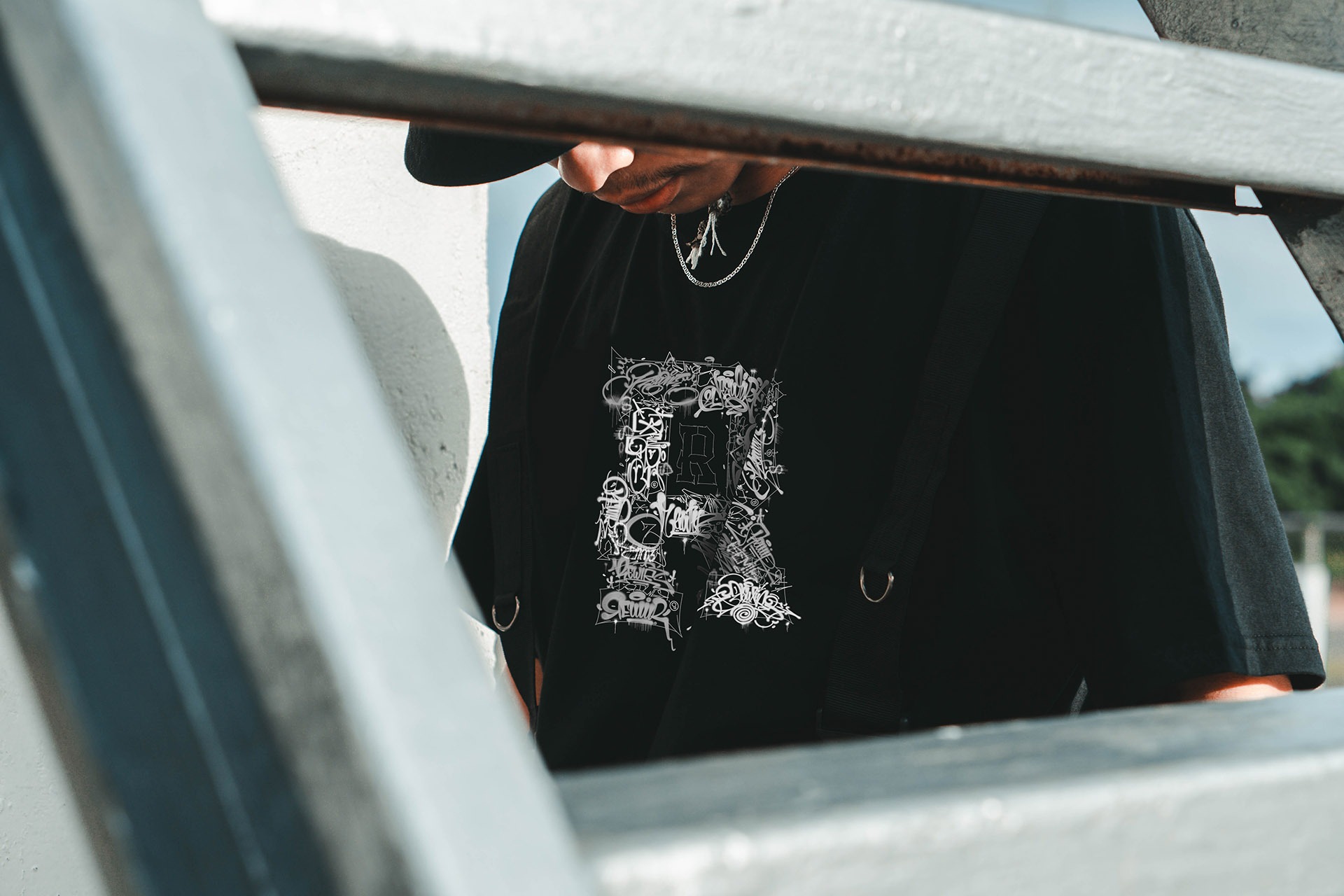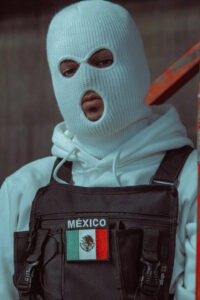
SOPEHS has been cooperating with REWIR for some time. Quite recently, he created the R TAG pattern for us, with which things are available to order in preorder(this can be done until October 10).
We managed to talk to him a bit – about the realities of life in northwest Mexico, about the local graffiti scene, but most of all about tagging.
What is daily life like in Ciudad Obregón? The media often gives us pictures of the situation in Mexico as a bloody war between drug cartels. How is it actually?
In the district where I live, walking at night, especially with a backpack

filled with cans that are buzzing is quite risky. Ciudad Obregón is an exceptionally dense space pierced by a lack of security. Poorly lit, damaged streets, where robberies often take place. There is practically no place in our city that has not been shot or executed by a member of the enemy cartel. People live in constant fear.
Graffiti writers have to be careful even during the day, because in abandoned places, ideal for heaps, you can meet dangerous people. You have to think strategically. Making graffiti in Ciudad Obregón is not a job for those who lack imagination, because you can pay for this lack with your life.
A good tactic is to keep the situation under control. Before the action, it is worth checking social media for the previously mentioned events to assess the risk.
Often times, graffiti writers in Mexico are attacked by cartel members (marking their territories with inscriptions on the walls) because, for example, they made a throw-in in a place where they could not?
I have not encountered such a situation directly. However, the general climate of danger and suspicion puts you in a constant state of tension while painting. The danger is much greater than the risk of being caught by the police and charged with vandalism. You can be considered a robber or a member of a rival cartel. In such situations, the police do not choose their means, especially the members of the cartels, who care about the territory of their influence. During graffity action, you have to think about every move, and at the same time act quickly and decisively. You cannot lose concentration.
An interesting issue is the drug culture, or even the drug religion, that exists in Mexico. The cult of Jesús Malverde (patron of drug dealers and smugglers) and Santa Muerte (a figure symbolizing death). Artists (e.g. singers) praising drug bosses in their songs. How do Mexican graffiti writers feel about it?
In the state of Sonora, where I live, people pray more to San Judas Tadeo (saint of the Catholic Church, patron of difficult and hopeless matters – ed.), But there are also followers of Santa Muerte. These forms of worship, however, have nothing to do with the local graffiti world, which comes from the tradition of hip-hop culture. I don’t know of any writer who would be a follower of any of the characters you mentioned. Such motives do not inspire us, they are not part of what we do.
I will add, by the way, that the state of Sonora is located in the north of the country, more than 30 hours by car from the capital of Mexico City, where the largest national media have their headquarters. There, every, even the smallest, case of settlements between cartels is very much publicized. The neighboring state of Sonora is the famous Sinaloa, which has a fixed status in pop culture as one of the drug centers of the world. Meanwhile, we have even more violence, but there are no cameras. In broad daylight, you can hear the volleys from the AK-47, but the media are silent about it.
View this post on Instagram
You have been active in the graffiti environment for a quarter of a century. How would you rate the present condition of this culture compared to when you started painting?
If we compare with today, it has to be admitted that now it costs more $ to stay in the game, which you have to spend on materials.
The impact of street art is also noticeable, which due to its smoothing has social acceptance, which in turn makes outsiders more reluctant to graffiti. 10 years ago, people looked more favorably at illegal tags and puffs.
Globally, there’s a ton of skill in graffiti right now. Levels are rising all the time, also in Mexico. Due to the fact that today the world has no boundaries, you can admire the works of players from every corner of it. It is very motivating and raises expectations of oneself.
How does the Mexican graffiti scene fare compared to other world scenes?
In Mexico City, the country’s capital, the stage is world-class, as can be seen, for example, at the annual Meeting of Styles Mexico. Overall, the underground, illegal Mexican scene attracts many writers from neighboring countries – everyone wants to make their presence felt.
OK, how is the local scene in Ciudad Obregón?
Currently, the graffiti scene does not exist here – there are no throws in the streets, no writers’ teams, no stores to buy. Only a few players are active, including me.
It was different in the mid-1990s, the very beginning of the graffiti culture in Obregón. It immediately started with a thick pipe. There were a lot of teams that bombed the city, many taggers marked the area with their nicknames. This boom faded out after a few years. Then there was a slight awakening around 2005, but that energy was exhausted quite quickly.
View this post on Instagram
What is most important to you in graffiti?
The most important thing in graffiti is the internal, constant desire to do it. You leave tags because you really want it, not because of the opinions of others. Of course, it is a nice feeling if your style is attractive not only to you, but the most important thing is your inner thirst, which you cannot quench with any other activity.
Unfortunately, money is often the problem. Many of us have a hard time at work all week just to have paint and paint on the weekend.
The most painful situation that happened to you while making graffiti?
The shop owner shot us when we wanted to get on the roof to throw in.
When browsing your Instagram profile, it is immediately obvious that you do tags the most, prefer handstyle. What is behind this choice?
Tags are very “economical”, so you can satisfy the desire to make graffiti even in the absence of materials and limited funds. As you know, you can prepare the ink for the marker filling yourself.
I am perfecting my style all the time. I spend most of my time tagging. I am often haunted by the thought “this is ruining your life,” but always a moment later there is an overwhelming urge to make a tag and all doubts disappear.
Do you remember your first tag and where did you make it?
From what I can remember, it was the caption “Dr. Dre ”and left it in my family home… on the washing machine.
If you found out you had one last tag in your life to make, where would you leave it?
Probably in one of those interesting places in Europe where my colleagues operate.
View this post on Instagram
Can you reveal what you do on a daily basis when you are not tagging?
The last time I had a “normal” job was 6 years ago. Now I only focus on handstyle. It’s enough for my needs.
Besides, the standard: I read books, watch movies, listen to rap, spend time with my family and friends.
Can you tell about your cooperation with REWIR?
It started with a tag project (drop with a theme with signatures of 60 writers from around the world – editor’s note). I really liked the idea, especially the fact that both writer’s legends that I admire and fresh talent were invited to implement it. The effect is great, it is a real pleasure to be a part of this event.
Now I made a pattern for REWIR – the letter “R” made of my tags. He found, among others on T-shirts, longsleeves, wipes.
Finally, would you like to say something to Polish fans of your style?
If there are really fans of my style in Poland, I have no choice but to thank them for following my movements.
Poland is a great country. While working with REWIR, I started to read about Warsaw, which has a very interesting and at the same time quite tragic history.
I send big greetings to everyone. Blessings ¡
TALKED: Paweł Konar
